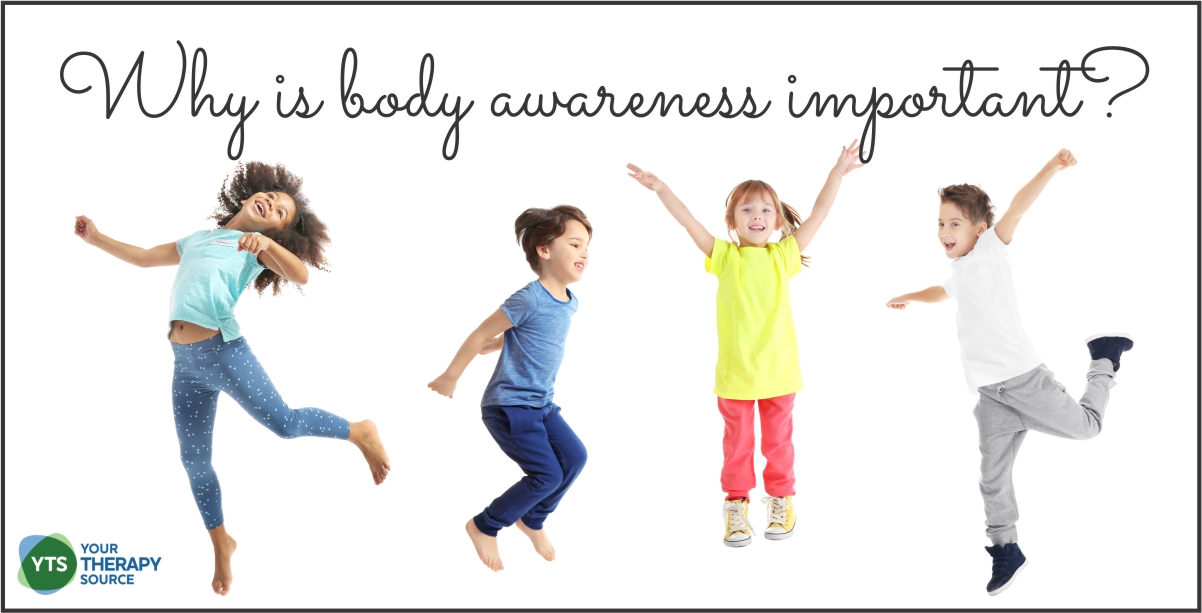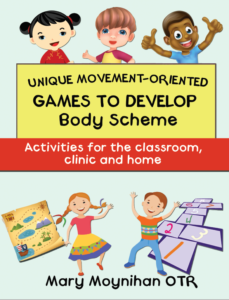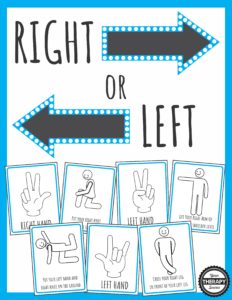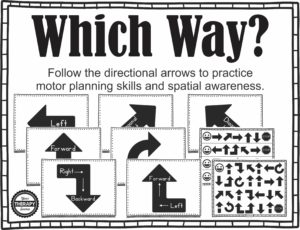Why is Body Awareness Important?
Body awareness is the ability to recognize where your body is in space. Your muscles and joints send your brain information about your body and how it moves. You may wonder why is body awareness important?
Body awareness helps us to understand how to relate to objects and people at home, at school and outdoors. For example, proper body awareness tells us how far to reach for objects or how close to stand next to a person.

Sometimes, if people have difficulties with body awareness they may appear clumsy, uncoordinated or have delays in motor skill development.
Body awareness is important to teach throughout childhood development because research indicates that the multisensory foundations of the bodily
Body Awareness and Spatial Awareness
Spatial awareness is the ability to understand and interact with the environment around you. Whether it be avoiding obstacles when walking, reaching out to grab a pencil or determining left from right these are all examples of tasks that require spatial awareness. Developing the skills to express and understand spatial skills are the first step in understanding spatial ability and awareness such as math skills, visual perceptual skills, and body awareness.
Research indicates that visual-spatial abilities contribute to a larger extent to children’s verbal number skills than verbal abilities which is important for the conception of early mathematics assessments and interventions. In addition, the role of spatial skills, notably spatial orientation, were important for mathematical development.
Visual spatial skills have also been shown to be related to motor coordination and handwriting skills.
How can you help children develop body awareness?
There are many ways you can help children develop body awareness. Start out by reviewing and identifying body parts. Begin with very simple commands such as kick your leg, wave your hand or shake your head. Then progress to motor commands such as “touch your elbow”. Then progress to more difficult commands such as “touch your right knee”.
You can make the skills even more difficult by practicing touching different body parts to different body parts ie touch your left hand to your right ear, put your right elbow on your left thumb, etc.
Activity Ideas for Body Awareness
Trying playing games that reinforce body awareness such as Simon Says or Follow the Leader.
Practice drawing pictures of people or ask the child to draw a picture of himself or herself. Name body parts as they are drawn.
Set up obstacle courses for the child to go over, under, around and in between objects.
Complete heavy work activities such as pushing, pulling or carrying heavy objects. This will help to reinforce where the joints and muscles are in space.
Sometimes a child may benefit from changes to the environment in order to help with body awareness. Try putting an ‘X’ on the floor where you want the child to sit. Perhaps a chair with arms on it will help to provide an external cue of where the body needs to stay seated. The child may do better walking at the front or back of a line instead of in the middle of the line. To prevent the child from slipping out of the chair or from knocking objects over put non-skid materials (ie rug gripper) on the seat or
Resources to Help Children Develop Body Awareness

Here is a fun freebie – 6 Body Part Awareness Activities and Printables. You can download your FREE below.
Directions:
Print the two pages. Laminate for durability.
Activity #1: Point to different body parts on the boy or the girl. Ask the child to point to the same body part on him/herself.
Activity #2: Point to different body parts on the boy or the girl. Ask the child to point to the same body part on someone else.
Activity #3: Shake your wiggles out. Point to a body part. Shake the body part. Continue selecting different body parts and wiggle it.
Activity #4: Put a piece of at least 6” painter’s tape on the floor or wall. Point to a body part. The child should put that body part on the tape. For example, if you point to the arm, the child should touch his/her arm to the piece of tape on the floor.
Activity #5: Describe a body part. See if the child can point to the correct body part. For example, the first clue could be “this body part is next to the hand”. The second clue could be “you wear bracelets on this body part” then the child has to guess “wrist”.
Activity #6: Ask the child to touch three body parts. The child has to remember the correct order to touch the body parts. For example, point to the hand, toes and stomach. The child has to then touch his/her hand, toes and stomach in that exact order.
Enter your email to access your FREE BODY AWARENESS ACTIVITIES AND PRINTABLES
MORE BODY AWARENESS ACTIVITIES:

Collection of activities to teach children about personal space including many body awareness exercises and a social story on personal space

This download includes 68 body position cards (full page), 13 Simon Says Stop cards and 25 game ideas to use with the Simon Says cards. It also includes all the 81 picture cards in a smaller size (2.5″ by 3.25″ – nine cards to one page). Print the cards or play the Simon Says game using the electronic PDF on a screen or a tablet. This activity encourages body awareness, bilateral coordination, motor planning and following directions.
Unique Movement Oriented Games to Develop Body Scheme – Activities for the Classroom, Clinic, and Home is a fun and creative resource written by Mary Moynihan OTR/L that facilitates children to develop a mature body scheme. When children participate in these unique gross motor activities, which are portable and easy to set up in a small area, therapists, teachers, and parents can help children have fun, while also improving their motor skills. FIND OUT MORE.

Download includes action poses for children to practice motor planning, crossing midline, body awareness, timing, rhythm, coordination and physical activity.
How to Help Children Learn Right from Left
An important aspect of body awareness and spatial skills is learning directionality i.e right from left.
Here are 5 ways to help children learn right versus left:
1. Verbal Reinforcement: Every opportunity you have verbally state right from left. For example, when dressing a child say “put your right arm in the sleeve”. When turning left in a car or walking on the street say “let’s take a left here”.
2. Visual Reinforcement: Have the child hold his/her palms down in front with the thumbs touching. The left hand makes the letter ‘L”.
3. Body Awareness Games and Activities: Dance the Hokey Pokey and play Simon Says again reinforcing right and left sides of the body. Do lots of bilateral coordination activities like jumping jacks, jumping rope, cross crawls, crawling, etc.
4. Obstacle Course: Set up a fun obstacle course that includes right and left directions i.e. have the child go to the left of the desk, to the right of the chair and under a table.
5. Use Tactile Reinforcement: With gentle but firm pressure, touch the right side while saying the body parts on the right side. Repeat on the left side.
Resources to Help Children Learn Right from Left
Do your students struggle with the concepts of left and right? Do they have difficulties visual tracking from left to right? Left or Right Worksheets digital download includes 20 black and white worksheets to help learn the concepts of left and right. Directions include writing from left to right, coloring objects on the left or right, circle the correct direction, handwriting activities and more. Encourage visual-spatial skills.
Right or Left Games digital packet helps children to practice right and left discrimination, bilateral coordination, fine motor skills, balance skills, body awareness, motor planning
Which Way? includes 16 directional arrow pages (large and small size) plus 6 boards to follow. The activities are available in varying degrees of difficulty. Children will practice moving right, left, diagonally, forwards, backwards, clockwise, down and up. Practice motor planning skills, visually scanning from right to left, understanding prepositional phrases and spatial awareness with this movement activity.
Conclusion – Why is Body Awareness Important?
Body awareness is important to teach to help children develop the spatial skills necessary to relate to objects and people at home, at school and outdoors. This can be done through verbal, visual, physical activity and especially active exploration of the environment. Body awareness and spatial skills are also related to the development of math skills.
References:
Cornu, V., Hornung, C., Schiltz, C., & Martin, R. (2017). How Do Different Aspects of Spatial Skills Relate to Early Arithmetic and Number Line Estimation?. Journal of Numerical Cognition, 3(2), 309-343.
Cornu, V., Schiltz, C., Martin, R., & Hornung, C. (2018).
Cowie, D et al. The development of multisensory body representation and awareness continues to 10 years of age: Evidence from the rubber hand illusion. Journal of Experimental Child Psychology. Volume 142, February 2016, Pages 230–238.
Scordella, A et al. The role of general dynamic coordination in the handwriting skills of children. Front Psychol. 2015; 6: 580. Published online 2015 May 7. doi: 10.3389/fpsyg.2015.00580







